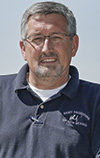Every milking parlor is unique in its configuration (i.e., herringbone, parallel, rotary or other variations), staffing levels, milking routine, shift duration, milking equipment and tools (i.e., cluster design, dip cup or spray, etc.), and other characteristics.
Additionally, parlor milking involves highly repetitive tasks, potentially high muscle forces and awkward or extreme postures, all of which are recognized as risk factors for the development of musculoskeletal disorders among workers (everything from carpal tunnel syndrome to degenerative disc disease). Additionally, work organization factors such as work-rest schedules or environmental conditions such as heat, cold or wet conditions can also adversely affect worker health and safety. These ergonomic risk factors can also contribute to worker fatigue, which ultimately can result in reduced worker performance or compromised worker health.
Recent research at the High Plains and Intermountain Center for Agricultural Health and Safety (HICAHS), headquartered at Colorado State University, has demonstrated a high prevalence of reported musculoskeletal symptoms among parlor workers, especially in the upper extremity. Another study demonstrated a high percentage of workers’ compensation injury claims were associated with work inside the milking parlor. Therefore, the application of sound ergonomic principles has the potential to improve worker health and safety.
There are a myriad of definitions and conceptions of ergonomics. A simple definition of ergonomics is the study of work. A more detailed definition is an applied science concerned with designing and arranging the environment so that workers interact with their environment in the most efficient and safe manner. There are four common objectives of sound ergonomic design as it relates to the workplace, which include:
- Efficient production
- Improve product quality
- Improve quality of work life
- Optimize health and safety of the worker
A relatively recent construct related to animal, environment and human health is the One Health concept. The One Health concept recognizes that the health of humans is connected to the health of animals and the environment. The One Health concept can be applied to milking parlor ergonomics. Parlor productivity and efficiency involves interactions between the cow, working environment and worker.
An often forgotten reality is that milker performance can have a profound influence on milk production, cow health and parlor productivity. An inconsistent or improper milking routine can prolong or reduce milk let-down, increase milking time, adversely affect udder health, milk quality and decrease optimization of milk harvest volume.
Conversely, both the working environment and the cow can also have an influence on worker performance and health. Several factors may contribute to process drift and milking inconsistency and productivity, including a lack of training, human error, fatigue, milking tool design and discomfort or injury. To date, little attention has been placed on the parlor milker and his or her interaction with the cow, equipment or working environment. Sound ergonomics in the parlor has the potential to maximize worker performance and health, as well as parlor productivity and efficiency.
Dairy farm owners, managers, supervisors and other decision makers should be aware of the ergonomic risk factors associated with the development of musculoskeletal disorders among parlor workers, as well as appreciate how the application of sound ergonomic principles can positively influence worker performance as well as parlor productivity and efficiency. Milking tools, parlor designs and milking routines should take into consideration worker capabilities as well as variations in worker shapes and sizes. Dairy managers should recognize how parlor work influences worker fatigue, and how fatigue ultimately may result in compromised performance or even injury.
Current HICAHS research is investigating how parlor milking affects worker posture, motion, muscle forces, as well as fatigue and performance. Other studies are also investigating milking tool design and their influence on the worker. For further information related to current parlor ergonomic research, or other information related to parlor ergonomics or worker performance, please contact Dr. David Douphrate via email. PD
David Douphrate, Ph.D., MPT, MBA, CPE, CSP, is with the University of Texas Health Science Center, School of Public Health.
Nathan Fethke, Ph.D., CPE, is with the University of Iowa, College of Public Health.
Robert Hagevoort, Ph.D., is with New Mexico State University, Dairy Extension.
PHOTO: Dairy managers must be aware of the ergonomic risk factors associated with the development of musculoskeletal disorders among parlor workers and make adjustments to minimize the risks. Photo by Lynn Jaynes.






